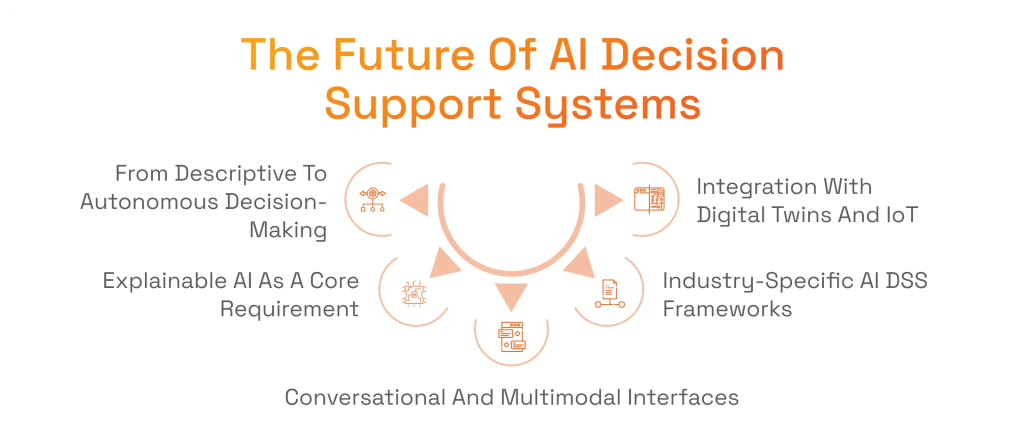The complexity of modern business decisions is outpacing the capabilities of traditional business intelligence tools. This is why it is high time for businesses to embrace artificial intelligence (AI) and leverage its full potential, especially given that, of the 78% of organizations that use AI in at least one business function, only 11% achieved to scale it across the enterprise.
When leaders are drowning in analytics without the clarity to act, an artificial intelligence decision support system (AI DSS) allows them to move beyond descriptive dashboards to predictive and prescriptive insights. In this article, we explore why these new AI-powered decision systems disrupt industries.
Decision Support System and Artificial Intelligence: Definition and Difference
Before AI DSS platforms, organizations generally relied on traditional decision support systems (DSS) as well as business intelligence (BI) tools.
DSS are computer-based systems designed to assist in decision-making for complex and non-routine problems. They combined raw data with models or predefined rules to support analysis. DSS could run what-if scenarios, simulate outcomes, or apply optimization techniques to guide managers. Traditional DSS heavily depend on static models.
BI, on the other hand, focuses on collecting, organizing, and visualizing historical data. BI platforms are built around dashboards and reports that pull information from data warehouses to create a single source of truth. This proves to be incredibly helpful as two-thirds of the global workforce now has access to BI tools that allow organizations to clearly see what has happened and why, track KPIs, identify trends, and monitor performance.
Once AI came into the picture, decision-making became more powerful and insightful. Instead of relying only on static reports, dashboards, or rule-based models, AI introduced machine learning, natural language processing, and advanced algorithms to DSS. These technologies enable systems not only to analyze vast and complex datasets at speed but also to detect hidden patterns, forecast outcomes, and even recommend optimal actions.
Several essential components make AI DSS powerful:
- Data pipelines ensure continuous flows of reliable structured and unstructured data into the system.
- Machine learning models uncover trends, predict outcomes, and adapt as new data arrives.
- The explainability layer provides transparency into how recommendations are made.
- User interface delivers insights in an intuitive format.
Today, businesses can use both AI-driven DSS and AI-based BI. What sets AI decision support tools apart from AI-based BI is their focus on action rather than insight alone. AI for business intelligence enhances dashboards and reports with advanced analytics to highlight trends and predict outcomes, but they still leave the interpretation and decision-making to humans. An AI DSS goes further by embedding prescriptive intelligence directly into the process. Instead of simply highlighting patterns or forecasts, it recommends the best course of action.
BI tools continue to play a vital role alongside AI-based DSS.
Discover their applications and impact in our article on business Intelligence and data visualization.
Why Businesses Are Turning to AI Decision Support
It is reported that companies using data-driven insights can achieve 10–15 % more revenue growth than peers. This is why businesses leverage artificial intelligence decision support systems, which help them move quickly, minimize bias, and make decisions they can trust. Below are more reasons why organizations are increasingly turning to AI-based decision support.

Managing Complexity in Multi-Variable Decisions
Nowadays leaders must balance financial metrics, operational efficiency, customer preferences, regulatory constraints, and competitive pressures to make decisions. Intelligent decision support systems can process vast datasets across these variables and identify correlations and trade-offs that may go unnoticed by humans. Thus, these systems synthesize complex inputs into actionable recommendations for organizations to avoid oversimplified thinking and make more balanced choices.
Gaining Predictive and Prescriptive Capabilities
AI-powered decision support goes further than descriptive insights, offering predictive and prescriptive capabilities. Predictive models forecast outcomes under different scenarios, while prescriptive analytics suggest the best course of action. Thanks to these capabilities, organizations get the possibilities to anticipate risks and market opportunities as well as proactively allocate resources instead of reacting to problems after they arise.
Accelerating Time-to-Decision in Fast-Moving Markets
The combination of a decision support system and artificial intelligence accelerates time-to-decision because of continuously analyzing real-time data and surfacing insights instantly. This enables decision-makers to act quickly, without sacrificing rigor or accuracy. With these technologies, organizations gain the agility to adapt faster than their competitors by responding to shifting customer demand, supply chain disruptions, or regulatory changes.
Reducing Human Bias with Data-Backed Recommendations
No leader can escape cognitive biases, personal preferences, or incomplete information, which cause inconsistent or suboptimal decisions. Luckily, an AI-based DSS helps reduce subjectivity by grounding recommendations in data-driven analysis. These systems evaluate variables and, thus, promote more equitable and evidence-based choices without emotional noise. Importantly, AI does not replace human judgment but supports and improves it, providing a factual counterbalance to intuition.
Enhancing Explainability and Trust with Explainable AI DSS
An explainable AI decision support system (XAI DSS) helps understand how recommendations are generated and why certain options are favored. It is done by providing transparency into their logic, highlighting key variables, and showing the rationale behind conclusions. XAI DSS makes it easier for leaders to validate insights, build confidence among employees, and satisfy regulatory or ethical requirements.
Serhii Leleko
ML & AI Engineer at SPD Technology
“The key difference between XAI vs regular AI in decision support is interpretability: while regular AI produces outcomes without context, XAI reveals the reasoning behind them and makes AI outputs trustworthy and defensible.”
Key Capabilities of an AI Decision Support System
AI hype vs reality often reveals a gap between bold promises and practical outcomes. An AI decision support system helps close that gap by turning data into actionable insights. To see where the real value lies, let’s explore the key capabilities of AI DSS and how they can be applied in your organization.

Real-Time Data Integration Across Sources
This capability connects IoT streams, ERP, CRM, web analytics, partner feeds, and third-party databases into a unified layer that organization can keep continuously refreshed. It harmonizes schemas, resolves identities, and reconciles conflicting records so companies’ leaders operate from one version of the truth. In the decision support stack, it supplies timely context for every model and dashboard, which grants decision-makers with sharper situational intelligence and faster decision alignment.
Predictive Analytics for Forecasting and Risk Management
Anchored in modern data infrastructure and analytics, this function applies statistical and machine learning to estimate future outcomes, quantify uncertainty, and detect emerging patterns. For AI DSS, governed pipelines translate historical signals into such scenarios as demand curves, churn probabilities, fraud likelihoods, supply delays for leaders to see risks and opportunities. Thanks to these scenarios, decision-makers get the chance to stress-test assumptions, rank business drivers, analyze competition. In other words, they can dynamically plan their actions and improve resource allocation. For instance, they can position inventory ahead of demand or tighten credit exposure when they see the possibility of risks.
Prescriptive Modeling for Recommended Actions
Prescriptive modeling in AI decision support platforms helps companies decide on the best course of action instead of just predicting what will happen. Using advanced techniques like optimization and simulation, it weighs different options against real-world limitations such as budgets, capacity, and regulations. It then recommends the specific actions that will deliver the most value. Essentially, it turns strategy into actionable steps, connects predicted results to specific business levers like pricing, product mix, scheduling, and staffing. This gives organizations a big advantage: they get consistent and precise decisions quickly.
Natural Language Interfaces for Accessibility
To make sure a DSS democratizes analytics, such a platform is usually equipped with natural language processing and provides explanations in everyday language across chat, voice, and embedded workflows. The analytics democratization is done through removing specialized syntax and surfacing data with citations, definitions, and drill-downs. In this manner, an AI-powered system for decision support can extend insight to the functions that make decisions like sales and call centers. The benefits are broader adoption and faster time to answer: frontline teams get contextual responses, analysts refocus on high-value work, and executives gain a shared narrative anchored in transparent sources.
Continuous Learning With MLOps-Enabled AI DSS
This feature ensures models remain accurate, safe, and cost-effective as data and behavior shift thanks to automated pipelines, feature stores, experiment tracking, CI/CD for models, and real-time monitoring for drift, bias, and performance regression. MLOps turns promising experiments into dependable services with versioning, lineage, and rapid rollback. Additionally, models are retrained when the world changes, outages are detected before they matter, and compliance is supported through auditable processes. As a result, companies can expect sustained ROI and lower risk.
Industry Use Cases of an Artificial Intelligence Decision Support System
By the second half of 2024, generative AI is reported to be regularly used in at least one function by 71% of organizations across industries. That means that now companies plug decision support into their BI/ERP/CRM and workflows. Below we explain how they do it.

Finance — Portfolio Risk Assessment and Fraud Detection
In the financial sector, AI decision support systems are used to enhance portfolio management since they can continuously analyze market data, economic indicators, and client profiles, assessing exposure and recommending balanced allocations. For example, we helped a European investment research firm to transform its legacy admin portal into an AI-enabled DSS for institutional investors. The solution now integrates advanced analytics, intelligent automation, and machine learning to deliver faster insights and actionable portfolio recommendations.
Also, AI for financial technology, including a DSS, is capable of spotting anomalies in transaction patterns, flagging suspicious behavior in real time. These capabilities provide the possibility for decision platforms to detect fraud and protect financial businesses and their clients.
Healthcare — AI DSS for Diagnostic and Treatment Support
Decision support systems that use AI and machine learning in healthcare assist clinicians by processing vast amounts of patient data, medical histories, lab results, and imaging records. These systems highlight likely diagnoses, suggest evidence-based treatment options, and flag potential risks such as drug interactions or complications.
For instance, our team leveraged AI and ML as well as computer vision and retrieval-augmented generation to develop a skin care application that analyzes visual data and identifies issues such as acne, wrinkles, necklines, and more and provides personalized recommendations for treatment. The app offers a 90% accuracy rate in detecting facial imperfections, which also promotes better treatment.
Retail & eCommerce — Demand Forecasting and Pricing Optimization
Demand forecasting in retail with machine learning equips an AI decision support platform with the capabilities to analyze sales histories, seasonal trends, and external signals to anticipate customer needs with high accuracy. It predicts fluctuations in demand, the system helps retailers optimize inventory levels, reduce stockouts and overstocks, and adjust pricing dynamically.
Equally, using AI for customer behavior analysis ensures that a DSS can segment audiences, uncover evolving preferences, and personalize promotions with precision. In such a way, retailers anticipate what customers will buy and also understand why they make those choices. Consequently, businesses can set up targeted marketing, smarter product recommendations, and dynamic pricing strategies that resonate with individual shoppers to drive sales and customer loyalty.
Construction — Predictive Maintenance and Supply Chain Optimization
In construction, AI DSS are deployed to monitor equipment health, predict failures, and schedule maintenance before costly breakdowns occur. With the use of predictive maintenance with machine learning, decision support transforms raw sensor data into actionable insights. Thus, the system identifies subtle patterns that indicate wear or malfunction for managers to optimize service schedules.
At the same time, DSS can leverage AI in the supply chain to analyze logistics to anticipate material shortages, optimize vendor selection, and align deliveries with project timelines. For example, we helped HaulHub’s platform digitize the construction material supply chain by replacing paper-based ticketing with AI-driven data capture and analysis. With AI models analyzing delivery tickets, classifying material data, and monitoring traffic around construction zones, the system streamlines coordination between plants, contractors, and transportation departments.
Serhii Leleko
ML & AI Engineer at SPD Technology
“Utilizing AI in supply chain operations helps cut delays, reduce inefficiencies, and give teams a real-time view of material flows. And the best part is that it is automated decision support: no need for manual processes when there is AI-powered oversight.”
The Future of Decision Support Systems and Artificial Intelligence
The adoption of AI DSS across industries will continue to rise. To be effective, this adoption must be supported by strong engineering expertise and deep AI know-how. When these skills are applied, businesses can unlock a number of significant transformations.

From Descriptive to Autonomous Decision-Making
In the near future, the systems that help businesses make decisions will be moving away from just describing what happened toward making autonomous decisions. Traditional systems told organizations what had already occurred, but AI-driven ones will predict what might happen and get recommendations on what to do.
The next step is even more automation, but it’s crucial to balance this with human oversight to guarantee the trust in the system. To avoid the risks of “black-box” models that are impossible to understand, companies will need to design these systems carefully, applying advanced expertise as a part of AI development services.
The Rise of Explainable AI Decision Support Systems
As AI recommendations become more common in critical fields like finance, healthcare, and regulatory compliance, transparency and explainability will be obligatory factors regulators will check. This can be the beginning of explainable AI decision support systems.
Such platforms show companies the data and logic used to create insights. Building these systems requires partnering with a vendor who has technical expertise in ML and deep knowledge of the specific industry because in-house teams, which possess strong domain knowledge, may not always have enough know-how in AI/ML to ensure the decisions are both accurate and trustworthy.
Conversational and Multimodal Interfaces for AI DSS
Users will soon expect to interact with AI DSS using their own voice, simple questions, and a mix of text and visuals. This change will make high-level insights accessible to every employee, no matter their role, turning complex data into easy-to-understand information.
However, this convenience for users comes with a major challenge for system developers. To make this vision a reality, companies will need partners who are experts in natural language processing, voice recognition, and business intelligence integration to create user-friendly yet advanced systems for decision support.
Integration With Digital Twins and IoT Ecosystems
The future DSS systems will involve real-time, dynamic interaction with digital twins of factories, supply chains, and even entire companies. AI and IoT will be coupled together in platforms to constantly analyze live data to simulate operations, predict what will happen next, and instantly adapt strategies. To achieve this, companies will need robust data pipelines and strong system architectures that can handle massive amounts of streaming information.
Building and maintaining these systems requires more than just AI expertise. It demands strong data engineering and MLOps practices to make sure real-time decision support stays reliable and scalable for the entire organization.
Industry-Specific AI DSS Frameworks
Companies will see custom AI solutions for decision support built to match the specific rules, risks, and day-to-day operations of different industries, such as fintech, healthcare, and manufacturing.
In these fields, decision-making is too complicated and heavily regulated for a one-size-fits-all approach. To meet this need, vendors will need deep knowledge of the specific industry to create AI DSS that are not only technologically smart but also perfectly aligned with that industry’s unique needs.
Conclusion
Decision support and artificial intelligence form a powerful combination that provides organizations with the capability to analyze vast data sets and suggest powerful business actions. AI DSS help companies manage complexity in multi-variable decision making, gain predictive and prescriptive capabilities, accelerate time-to-decision, reduce human bias, ensure explainability and transparency of AI results.
Artificial intelligence decision support systems are capable of integrating real-time data from several sources, forecasting and managing risks, recommending actions, explaining results in a human-friendly manner, and learning continuously. These capabilities are extremely useful in a number of industries, including healthcare, retail, finance, and manufacturing.
The future of AI-driven DSS offers even more: autonomous decisions, explainability, conversational interfaces, integrations with IoT and digital twins as well as domain-specific frameworks. It is best to enhance DSS with AI with a trusted partner, who has experience in both advanced technologies and the nuances of making decisions in a specific niche. We help our clients to improve their decision-making, and we can help your business too. Just reach out to us if you need any assistance.
FAQ
What Are the Best AI Decision Support System Tools?
These tools are designed to serve as comprehensive solutions for data analysis, BI, and automated decision-making: Domo, SAS Intelligent Decisioning, Pyramid Analytics, Sisense, and Palantir Artificial Intelligence Platform.
However, off-the-shelf platforms often come with limitations like rigid workflows, unnecessary features, and high licensing costs that may not fully match your business model. Custom systems, on the other hand, are built around your unique processes and offer seamless integration, greater flexibility, and long-term scalability.
How Does an AI DSS Differ from a Traditional DSS?
Traditional DSS tools analyze historical data and provide descriptive insights, often requiring human interpretation. An AI-driven DSS goes further by applying ML and advanced algorithms to predict outcomes, recommend actions, and improve decisions through adaptive learning.
What Is Explainable AI in the Context of DSS?
XAI ensures that the reasoning behind AI-driven recommendations in a DSS is understandable. It builds user trust, supports regulatory compliance, and helps decision-makers validate outcomes.


